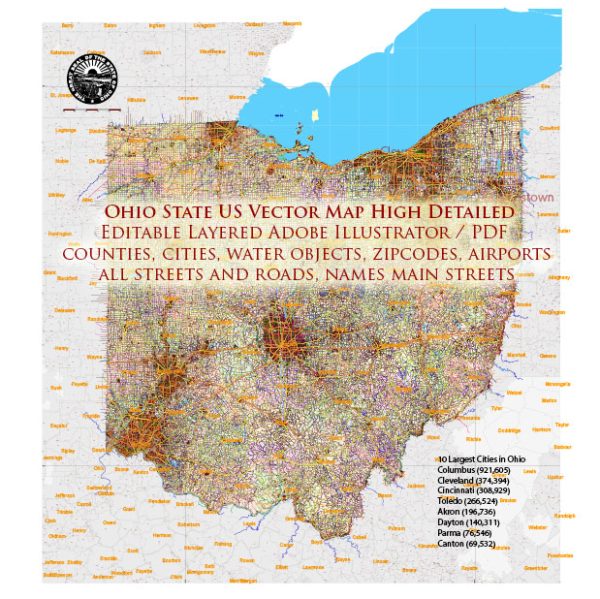The economic history of Ohio, a state in the Midwestern United States, is marked by a diverse range of industries and economic transformations over the years.
Vectormap.Net provide you with the most accurate and up-to-date vector maps in Adobe Illustrator, PDF and other formats, designed for editing and printing. Please read the vector map descriptions carefully.
Here is a detailed overview:
- Early Economy (Pre-19th Century):
- Before European settlement, the region that is now Ohio was inhabited by various Native American tribes.
- The French and British both claimed the area in the 18th century, but after the American Revolution, it became part of the United States through the Northwest Ordinance of 1787.
- Agricultural Economy (Early 19th Century):
- In the early 1800s, Ohio’s economy was primarily agricultural. Settlers cleared land for farming, and crops such as corn and wheat became essential.
- The construction of the Ohio and Erie Canal (completed in 1832) facilitated transportation, connecting Lake Erie with the Ohio River and boosting trade and commerce.
- Industrialization and Manufacturing (Mid-19th Century):
- The mid-19th century saw the rapid growth of industrialization in Ohio. Cities like Cleveland and Cincinnati became major industrial centers.
- Iron and steel production, as well as manufacturing, played a crucial role in the state’s economy. Cleveland emerged as a major steel-producing city.
- Civil War and Post-War Growth (Late 19th Century):
- Ohio played a significant role in the Civil War, providing troops and materials. The war stimulated industrial production and infrastructure development.
- After the war, Ohio experienced continued industrial growth, with the expansion of railroads and the establishment of numerous factories.
- Early 20th Century:
- The early 20th century saw the rise of the automotive industry. Dayton, in particular, became a center for automobile manufacturing.
- The state’s economic diversity increased with the growth of rubber and tire production, with companies like Goodyear and Firestone establishing a presence in Akron.
- Depression Era and World War II:
- The Great Depression had a severe impact on Ohio’s economy. Unemployment rates soared, and the state suffered from economic hardships.
- World War II brought a resurgence of industrial activity. Ohio’s industries played a vital role in producing war materials, and the post-war period saw economic recovery.
- Post-World War II and Mid-20th Century:
- Ohio continued to be a manufacturing powerhouse, particularly in steel production and heavy industry.
- The 1960s and 1970s witnessed economic diversification, with growth in service industries and technological sectors.
- Late 20th Century and Beyond:
- The late 20th century saw the decline of traditional manufacturing industries in Ohio. The steel industry, in particular, faced challenges, leading to job losses.
- Ohio’s economy transitioned towards services, finance, and healthcare. The state became a hub for research and development.
- Recent Trends (21st Century):
- Ohio has faced challenges in maintaining manufacturing employment, but cities like Columbus and Cincinnati have experienced growth in technology and healthcare sectors.
- The shale energy boom in the 2010s brought economic opportunities, particularly in eastern Ohio, with increased natural gas and oil production.
- Challenges and Opportunities:
- Ohio’s economy faces challenges related to globalization and technological change, but it also presents opportunities for growth in emerging industries.
- The state continues to invest in education, infrastructure, and innovation to remain competitive in the evolving economic landscape.
In summary, Ohio’s economic history reflects its transformation from an agrarian society to a manufacturing powerhouse and, more recently, a diversified economy with a focus on services and technology. The state’s ability to adapt to changing economic conditions has been crucial for its sustained growth.


 Author: Kirill Shrayber, Ph.D.
Author: Kirill Shrayber, Ph.D.